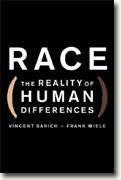Vincent Sarich & Frank Miele
book reviews:
· general fiction
· chick lit/romance
· sci-fi/fantasy
· graphic novels
· nonfiction
· audio books
· author interviews
· children's books @
curledupkids.com
· DVD reviews @
curledupdvd.com
newsletter
win books
buy online
links
home
for authors
& publishers
for reviewers

 |
Race: The Reality of Human Differences Vincent Sarich and Frank Miele Westview Press Hardcover 320 pages January 2004 |
|
The theory of monogenesis attracts strange bedfellows. To espouse it, you must believe that there are fewer and less important distinctions among racial groups because all races had a single point of origin. This lumps the Christian fundamentalists with the politically correct liberals, the former because they believe that God created one man and one woman to populate the earth, and the latter because they regard the opposite view, called polygenesis ,as socially dangerous. Monogenesis is a safe stronghold, but it forces its proponents to assume that society is constantly in need of correction for the sins of omission and commission associated with acknowledging racial differences.
The tendency to cite and characterize racial features is as old as humanity itself, including the Chinese classification of hairy white people as barbarians and the Bushmen’s assessment of all humans but themselves as “inedible meat.” However, as history proves, darkness of skin became a notable negative, and most non-African peoples have at one time or another ascribed to Africans the lowest possible human status, that of slave. Vincent Sarich is Emeritus Professor of Anthropology at the University of California, Berkeley, and FrankMiele is senior editor with Skeptic magazine. This interesting pairing makes for a book more than usually readable while fact-rich. Miele is a dog lover and skeins in some caninology to support certain of Sarich’s anthropological propositions. Most cogent, there are hundreds of breeds of dog which have arisen in a very short period of time, a few hundred years, in response to public taste and owner’s need. Could this phenomenon be seen in parallel with the notion of the rather recent (say, in the last 40,000 years) development of human racial differences? The authors argue that 40,000 years is plenty of time for the races to have developed highly distinctive potentialities based on obvious physical markers. There is perilous ground here, and the authors explore it unafraid, with the conviction that knowing and understanding facts shall make us free, rather than, as a commentary on an earlier and much-decried work, The Bell Curve, would have it: “the untruth is...better for American society than the truth.” If we acknowledge a mean average IQ of 70 among sub-Saharan Africans, what does this imply for the way we perceive that race of people? “Whites with a 70 IQ are obviously substantially handicapped...it is difficult to imagine their being able to form a social system among themselves.” Yet this doesn’t carry over to our observation of Africans, whose cultural structures are complex and intact. It seems that we can readily, if grudgingly, accept that people of the Indian subcontinent, who have a mean IQ of 85, have the drop on Americans when it comes to technology and high-level computer skills. But we have chosen to ignore the implications of the lower numbers, to the extent that a program which accepts or offers an edge to minorities is not capable of defining what a minority is, relying on self-screened definitions, or a personal meeting in which consideration will be given to “name, manner of speaking and phrasing, and personal appearance during an interview or orientation.” The authors cite a serial murder investigation in which many suspects were interviewed based on assumption that serial killers are ”white males ages 25 - 35.” Officials ignored the eyewitness who swore the suspect was a black man. The man ultimately arrested had DNA markers for 85% sub-Saharan African descent, 15% Native American. This is a relatively minor example of what forces can be brought into play by racial stereotyping, but it serves to establish the point that knowing more, and acknowledging the factual basis for what we know, is common sense. If a child by age three can recognize race and gender differences, and understands that these differences are immutable, why can’t we? The authors offer three possible socio-political scenarios based on their conclusions about race history and race difference. They suggest strongly that a society based on individual initiative will fare better in the long run than one based on either race “norming” or re-segregation. They do, however, point out that a society based entirely on the success of individual ambition and ability will lead to a large gap between rich and poor, since higher IQ, ambition and economic success are linked. This book will engender as much controversy as its predecessors in the same field, though its authors clearly set out to make the subject palatable to a wider audience. There is some small victory here, however, in that an academic and a skeptic have found common cause. © 2004 by Barbara Bamberger Scott for Curled Up With a Good Book |
|
|
|
 Click here to learn more about this month's sponsor! |
|
| fiction · sf/f · comic books · nonfiction · audio newsletter · free book contest · buy books online review index · links · · authors & publishers reviewers |
|
| site by ELBO Computing Resources, Inc. | |
 This is the nutshell, layman’s version of the praiseworthy attempt by the authors of Race to explain how most of us have become monogenesists, and why that might be comparable to admiring the legendary naked emperor.
This is the nutshell, layman’s version of the praiseworthy attempt by the authors of Race to explain how most of us have become monogenesists, and why that might be comparable to admiring the legendary naked emperor.